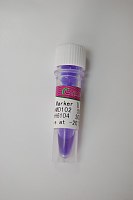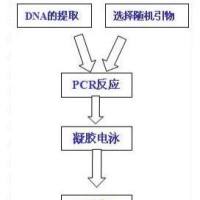Random Amplified Polymorphic DNA (RAPD)
互联网
The Random Amplified Polymorphic DNA (RAPD) method is based on the Polymerase Chain Reaction (PCR) using short (usually 10 nucleotide) primers of arbitrary sequences. Polymorphism of amplified fragments are caused by: (1) base substitutions or deletions in the priming sites, (2) Insertions that render priming sites too distant to support amplification, or (3) insertions or deletions that change the size of the amplified fragment.
Materials
Equipment : Thermocycler,Power supply Unit
Water : Sterile de-ionized or distilled water should be used for preparing all the reagents and pre-mixes
Reaction buffers: Assay buffer for Taq DNA polymerase ( supplied by the manufacturer of Taq DNA polymerase)
Deoxynucleoside triphosphates (dNTP"S): 2.5 mM each of dCTP,dATP,dTTP,dGTP. Readymade solutions of dNTPS are available from many manufactures. Store at –20 ºC
Magnesium chloride: 25mM stock and store at –20 º C
Taq DNA polymerase
Genomic DNA 5-25 ng/ml stocks. DNA of sufficient quality can be obtained in coconut by using SDS protocol.
Methods
2.5µl DNA stock (25ng/µl) 2.5µl Assay buffer containing 2.5mM MgCl2 (2.5mM) 1µl MgCl2 stock (1.5mM) 1µl primer stock (25pmol) 4µl dNTPS (400µM) 1µl Taq polymerase (1U) Sterile water to make 25 µlAssemble RAPD reactions as follows:
Temperature profile
General cycling steps followed are:
Step1: Initial denaturation at 94º C for 5.00 min
Step2: Denaturation at 94º C for 1.00min
Step3: Primer annealing at 55º C for 1.00min
Step4: Primer extension at 72º C for 2.00min
Step5: Go to 2, 39 times
Step6: Final extension at 72º C for 10min
Step7: 4º C for everAfter the reaction, DNA is analyzed through gel electrophoresis.
Agarose gel electrophoresis
Reagents for agarose gel electrophoresis
Gel Interpretation
Applications of RAPD
RAPD protocol can be used in genetic mapping and finger printing application in other palms like arecanut and oilpalm also.
Note: Ethidium bromide is a mutagen and a probable carcinogen. Wear gloves when working with ethidium bromide solutions. Also use care not to contaminate the work area with the solution. UV light is damaging and must be used with caution. UV light causes burns and can damage the eyes.







